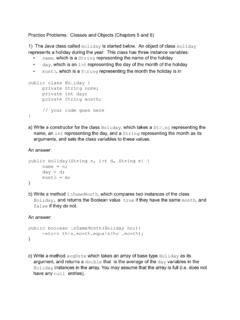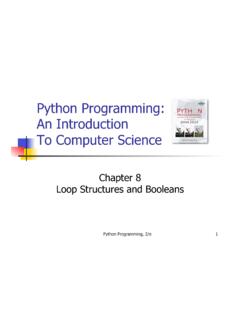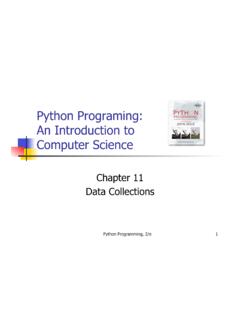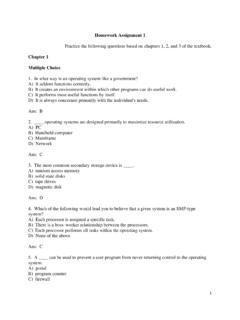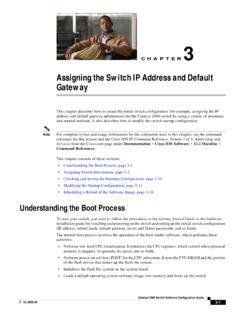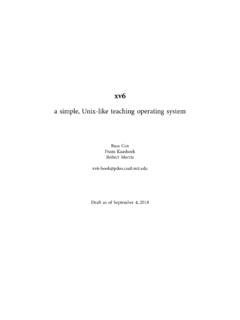Transcription of Homework assignment 4 (based on chapters 4 and 5)
1 1 Homework assignment 4 (based on chapters 4 and 5) chapter 4 Q&A 1. Which of the following items are shared across multiple threads belonging to the same process? A) code, data, files B) registers C) stack D) all of the above Ans: A 2. In a multithreaded server architecture, which of the following is used to service a new user request? A) a new created thread B) a new created process C) the same process for prior users D) none of the above Ans: A 3. Which of the following benefits go to multithreaded programming? A) responsiveness B) resource sharing C) economy D) scalability E) all of the above Ans: E 4. Which of the following refers to the capability to allow multiple tasks make progress on a single processor system?
2 A) concurrency B) parallelism C) data parallelism D) task parallelism Ans: A 5. _____ is a formula that identifies potential performance gains from adding additional computing cores to an application that has a parallel and serial component. 2 A) Task parallelism B) Data parallelism C) Data splitting D) Amdahl's Law Ans: D 6. _____ is not considered a challenge when designing applications for multicore systems. A) Deciding which activities can be run in parallel B) Ensuring there is a sufficient number of cores C) Determining if data can be separated so that it is accessed on separate cores D) Identifying data dependencies between tasks. Ans: B 7. Which of the following models are possible for the relationship between the user threads and kernel threads?
3 A) many-to-one model B) one-to-one model C) many-to-many model D) two-level model E) all of the above Ans: E 8. ____ is a thread library for Solaris that maps many user-level threads to one kernel thread. A) Pthreads B) Green threads C) Sthreads D) Java threads 3 Ans: B 9. The _____ model maps each user-level thread to one kernel thread. A) many-to-many B) two-level C) one-to-one D) many-to-one Ans: C 10. The _____ model multiplexes many user-level threads to a smaller or equal number of kernel threads. A) many-to-many B) two-level C) one-to-one D) many-to-one Ans: A 11. Which of the following is a function that can be provided by Pthreads API for constructing a multithreaded program? A) pthread attr init B) pthread_create C) pthread_join D) all of the above Ans: D 12.
4 In Pthreads, a parent uses the pthread_join() function to wait for its child thread to complete. What is the equivalent function in WinAPI? A) win32_join() B) wait() C) WaitForSingleObject() 4 D) join() Ans: C 13. Which of the following statements regarding threads is false? A) Sharing is automatically provided in Java threads. B) Both Pthreads and WinAPI threads share global data. C) The start() method actually creates a thread in the Java virtual machine. D) The Java method join() provides similar functionality as the WaitForSingleObject in Win32. Ans: A 14. The most common technique for writing multithreaded Java programs is _____. A) extending the Thread class and overriding the run() method B) implementing the Runnable interface and defining its run() method C) designing your own Thread class D) using the CreateThread() function Ans: B 15.
5 Which of the following is a method for implicit threading? A) thread pools B) OpenMP C) all of the above Ans: C 16. Which of the following options exist to deliver signals in multithreaded program? A) deliver the signal to the thread to which the signal applies B) deliver the signal to every thread in the process C) deliver the signal to certain threads in the process D) assign a specific thread to receive all signals for the process E) all of the above Ans: E 17. Which of the following options to deliver signals in multithreaded program should be applied to an asynchronous signal that terminates a process (<control> <C>, for example)? A) deliver the signal to the thread to which the signal applies B) deliver the signal to every thread in the process 5 C) deliver the signal to certain threads in the process D) assign a specific thread to receive all signals for the process E) all of the above Ans: B 18.
6 Which of the following options to deliver signals in multithreaded program should be applied to a synchronous signal? A) deliver the signal to the thread to which the signal applies B) deliver the signal to every thread in the process C) deliver the signal to certain threads in the process D) assign a specific thread to receive all signals for the process E) all of the above Ans: A 19. To associate each thread created using an implicit technique such as a thread pool, with its unique transaction identifier, we could use ____? A) global variable B) local variable C) static data D) thread-local storage Ans: D 20. LWP is ____. A) short for lightweight processor B) placed between system and kernel threads C) placed between user and kernel threads D) common in systems implementing one-to-one multithreading models Ans: C 6 21.
7 Which are included in the context of a thread? A) register set B) stacks C) private storage area D) all of the above Ans: D 22. Which of the following information is shared when the flag CLONE_VM in Linux clone() system call is set up? A) file-system information B) memory space C) signal handlers D) set of open files Essay Questions 1. Why should a web server not run as a single-threaded process? Ans: For a web server that runs as a single-threaded process, only one client can be serviced at a time. This could result in potentially enormous wait times for a busy server. 2. List the four major categories of the benefits of multithreaded programming. Briefly explain each. Ans: The benefits of multithreaded programming fall into the categories: responsiveness, resource sharing, economy, and utilization of multiprocessor architectures.
8 Responsiveness means that a multithreaded program can allow a program to run even if part of it is blocked. Resource sharing occurs when an application has several different threads of activity within the same address space. Threads share the resources of the process to which they belong. As a result, it is more economical to create new threads than new processes. Finally, a single-threaded process can only execute on one processor regardless of the number of processors actually 7 present. Multiple threads can run on multiple processors, thereby increasing efficiency. 3. Distinguish between parallelism and concurrency. Ans: A parallel system can perform more than one task simultaneously. A concurrent system supports more than one task by allowing multiple tasks to make progress.
9 4. Multicore systems present certain challenges for multithreaded programming. Briefly describe these challenges. Ans: Multicore systems have placed more pressure on system programmers as well as application developers to make efficient use of the multiple computing cores. These challenges include determining how to divide applications into separate tasks that can run in parallel on the different cores. These tasks must be balanced such that each task is doing an equal amount of work. Just as tasks must be separated, data must also be divided so that it can be accessed by the tasks running on separate cores. So that data can safely be accessed, data dependencies must be identified and where such dependencies exist, data accesses must be synchronized to ensure the safety of the data.
10 Once all such challenges have been met, there remains considerable challenges testing and debugging such applications. 5. Distinguish between data and task parallelism. Ans: Data parallelism involves distributing subsets of the same data across multiple computing cores and performing the same operation on each core. Task parallelism involves distributing tasks across the different computing cores where each task is performing a unique operation. 6. What are the two different ways in which a thread library could be implemented? Ans: The first technique of implementing the library involves ensuring that all code and data structures for the library reside in user space with no kernel support. The other approach is to implement a kernel-level library supported directly by the operating system so that the code and data structures exist in kernel space.
